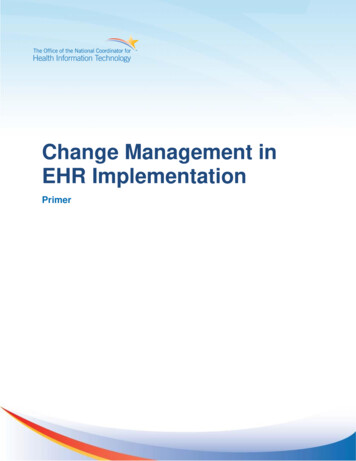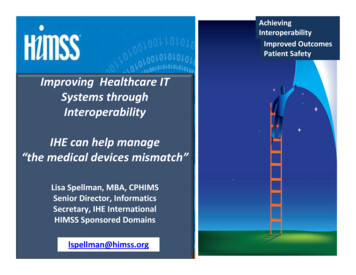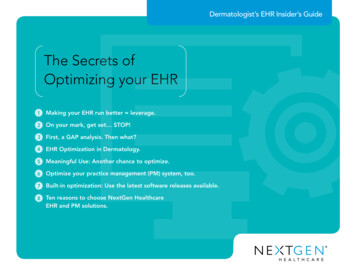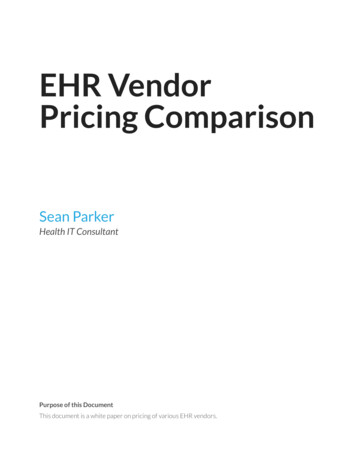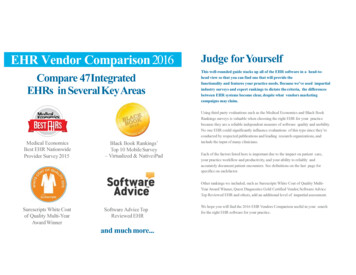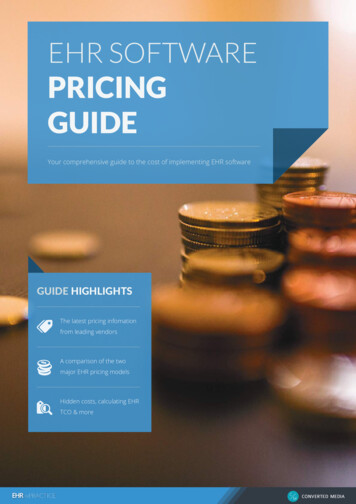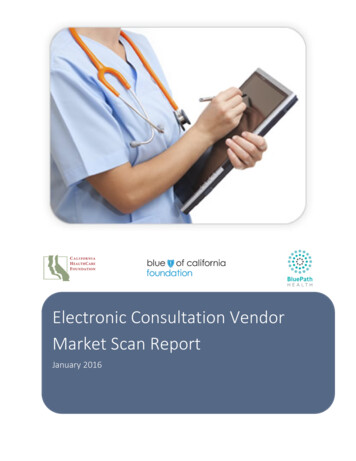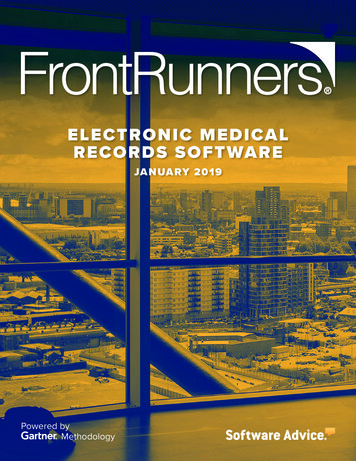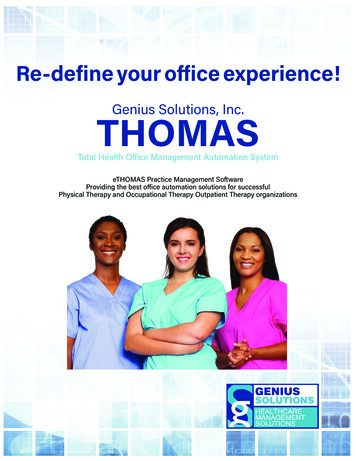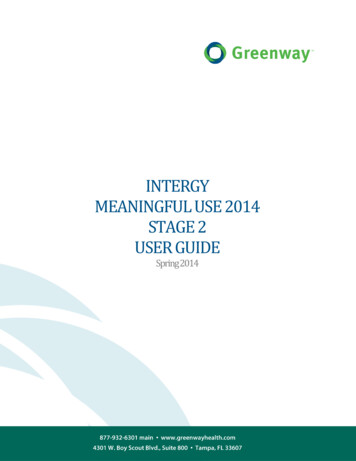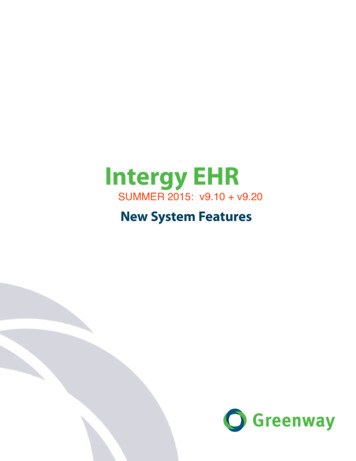
Transcription
EHRGO-LIVETHE DEFINITIVE EHR GO-LIVE IMPLEMENTATION GUIDE
EHR Go-LiveThe Definitive EHR Go-LiveImplementation GuideEdited By:Robert Steele, SVP Delivery/Operations, The HCigroupWill Adkins, Director, Go-Live Services, The HCigroup
TABLE OF CONTENTSForeword . 4Chapter 1 . 5Go-Live Preparation: Manage people in preparations to speed adoption andpreserve revenue integrity.Chapter 2 . 10Go-Live Planning: 5 essential steps to maintain an on time and under budgetseamless EHR implementation.Chapter 3 . 13Are you ‘Ready’ to Go-Live? 5 Keys questions to ask prior to Go-Live.Chapter 4 . 16It’s Go Time! Minimize disruptions in workflow and revenue by addressing thesecommon issues with people and processes.Chapter 5 . 19At-The-Elbow Support: The old system is “working just fine.”Chapter 6 . 22“Best” Practices you really should ignore. Consider what is best for yourorganization.Chapter 7 . 24Adoption: Just when you thought the Go-Live was the last step, along comes thequestion of support.Chapter 8 . 27Optimization: Building a proactive strategy for optimization.Chapter 9 . 30Clinical Adoption: 10 tips to meeting the needs of your clinicians and physicianswhen implementing new technology.Chapter 10 . 32Revenue Cycle Management: Key steps in preserving revenue integrity duringinstall.Contributors . 34
FOREWORD“TOO COSTLY.TOO COMPLEX.TOO CHAOTIC.You have likely used one or morwhen describing your perimpl“these terms, or some variant thereof,experience with—the Go-Live phase ofentingemyour electronic health record system.But Go-Live does not need to be the resource-Customer expectations continue to exceedsapping, bewildering and frustrating experiencethe pace of delivery, and they have expandedthat you are anticipating, or have endured. Youbeyond clinicians and physicians to includecan improve patient care and increase yourexecutives, management, patients, familiesrevenue if you manage your people, processesand more. Regulatory initiatives are drivingand technology properly.information technology roadmaps andinformatics teams are implementing newProactive planning built upon inclusivetechnology at a faster pace. The focus onassessment, efficient implementation byimplementation has left many organizationsexperienced health IT experts and ongoing,with a gap in knowing how well users havepersonalized support, will help you optimizeadopted the technology and whether they haveworkflow and adoption.gained the maximum value of their investment.For many years, healthcare facilities haveIncrease the return on your investment infocused on simply getting required informationyour EHR by deploying your people properly,technology in place. But there has beendefining your processes appropriately, andan important shift from installing theseusing your technology optimally throughout thetechnologies toPreparation, Go-Live and Adoption phases ofning how to best use themimpact the health ofto achieve outcomespatients across the nation. This shift presents anew set of challengesopportunities.your installation.
CHAPTER 1PreparationManage people inpreparations to speedadoption and preserverevenue integrity.Your EHR Go-Live shouldbe the culmination ofmonths of research,evaluation and planningby a multidisciplinaryteam comprised of a crossrepresentation of business,clinical and providermanagement and end-userrepresentatives. But sheereffort alone does not ensuresuccess.Preparation“Your EHR Go-Live should be the culmination of monthsof research, evaluation and planning by a multidisciplinaryteam comprised of a cross representation of business, clinicaland provider management and end-user representatives.But sheer effort alone does not ensure success.”The lack of a comprehensiveand coordinated approachto preparing for Go-Live could result in negativesatisfaction, adoption and sustainment—as well asperhaps harmful financial outcomes. You do notneed to be in the industry long to know that hospitalssometimes experience revenue challenges soon afterimplementing EHR systems. It commonly takes monthsfor clinicians to get back to their pre-Go-Live patientcare loads and for revenue to increase.each department or specialty ahead of the buildphase not only ensures involvement across the entirehospital, but allows your project team members tohave a direct link to concerns that may arise laterin the project that need to be addressed quickly orhave a high level of complexity. It’s also imperativethat you capture information on key pre-livebusiness metrics (such as CPOE percentage or actualrevenue vs. expected) in order to provide concretedata on how well, or poorly, your staff are comingThe sooner you plan, and the more detailed youralong; your vendor may have information to showplanning, the more likely you will avoid the perilsthem how it relates to their peers elsewhere as well.of a poor implementation. Identifying leaders for5 THE HCI GROUP THE DEFINITIVE EHR GO-LIVE IMPLEMENTATION GUIDE WWW.THEHCIGROUP.COM 866-793-2484
CHAPTER 1PREPARATIONIn this section, we look at how comprehensive, proactive management can help you to speed adoption andpreserve revenue integrity.PEOPLEHospital AdministratorsHospital administrators are vital to set the tone, momentum, and expectations for the entire hospital/health system’sacceptance of electronic charting. They must first believe in the product and the process of converting legacydocumentation to modern methods for electronic charting, then stand by the chosen vendor through all stagesof the transformation. This may sound simple and obvious however there will be challenges during the phases ofadoption that will test even the strongest supporters. Hospital administrators will set an example and motivate otherswithin the hospital system who expect to have their work lives and practices respected and managed properly.A lesson in how NOT to Go-Live.Poor adoption by physicians and the ensuing problems that it caused for a small hospital in California underscorethe implications of weak support by administrators.There were the usual training opportunities in place, with lots of time to get the staff and physiciansup to speed with the product, from a well-established and dependable vendor. However physiciantraining was not mandatory, and ultimately they were not required to use the system. Essentially,administrators for the hospital, which was part of a larger healthcare system, didn’t provide anytangible expectations for the physicians.As imagined, without training or commitment to moving from paper to an electronic system, theprocess of implementation deteriorated rapidly. Right away during implementation bright andtechnically savvy physicians found fault with the software. Reportedly it couldn’t do what theyexpected and they felt it was too time consuming. In spite of every effort to bring in developers,software engineers, and additional trainers the physicians would find little they could appreciateabout the product and quickly lost interest.Despite efforts by the hospital administrators to rally the physicians back into the system’s use, thephysicians eventually mounted such intense resistance that the members of the hospital’s medicalboard deemed the vendor’s product “unsafe”. Overwhelmingly, the board voted to prevent its useuntil the vendor could meet certain demands to prove there was no risk in using the product, whichby the way, had been proven multiple times with multiple clients over multiple years. Nevertheless,no amount of reassurance would help bring them back. Ultimately physicians at that particularhospital still charted in whatever way they pleased paper or electronic, or sometimes both.Through this example we see hospital administrators made great attempts to bring the process back into focus,but eventually couldn’t hold their ground. Lesson learned: In a conversion from paper to an electronic system,it is proper for administrators to establish a commitment from the end users by encouraging a contract, and by6 THE HCI GROUP THE DEFINITIVE EHR GO-LIVE IMPLEMENTATION GUIDE WWW.THEHCIGROUP.COM 866-793-2484
CHAPTER 1PREPARATIONmandating the training and use with the physicians. They should also ensure expert and effective support fromthe vendor. Hospital leadership must stand firm, within reason, alongside the vendor, in support of the processduring this kind of change.Vendor RepresentativesTime-tested EHR businesses are best suited for providing the most predictable and reliable services throughoutthe process of implementation. Companies like these have developed databases, established a degree ofstandardization, and are best equipped to provide skilled resources to support implementation. They knowwhat’s expected for them to provide a product that will satisfy client needs and meet the demands of governmentregulation. Vendors must be willing to work with new client sites in engaging physicians as early as they can inthe process so nothing comes as a complete surprise at the time of implementation. In addition, customizationof the product is one way to draw physicians’ interest. Reasonable expectations can be outlined in softwaredemonstrations. Furthermore, an honest description of what can and cannot be modified could remove anyunrealistic demands from the end users.Vendor representatives must also manage users’ expectations. For example, though time saving is the mostsought after quality of any EHR, users typically do not experience it right away because of the very nature ofchanging the process from paper to electronic. Your vendor’s representatives should clarify that change is hard,particularly if users fret about compromising productivity.Here are some particular trigger points for users’ pain and suggestions for how your vendor can alleviate the response:1. Give users the difficult news up front; Initially using an EHR does slow the work flow down.Ways that vendor representatives can alleviate initial change in productivity from a physician standpoint includea couple practical steps if hardware budgets will accommodate the need.1.Voice recognition software to speed up data entry to replace typing.2.Have devices in close proximity and have enough for use, physicians will not go out of theirway to find a device.The application will never be “perfect” for everyone, and change typically doesn’t come quickly with EHRs, butvendors should welcome suggestions for improvement. They also need to offer reasonable customization to theexisting software. Showing clinicians how the software can enhance patient care—rather than detracting fromit by taking away time—can also be helpful. Vendor representatives may want to integrate a computer intothe experience by showing clinicians the patient screens that display graphic trends, or screens that illustrate apoint about the importance or severity of a condition, for example. Demonstrating that patient privacy is betterprotected than with paper systems is beneficial as well. Ask your vendor’s representatives to demonstrate howevery electronic entry has a date/time stamp that states which provider/clinician opened the record. This isbetter than currently, where anyone can open the paper record and anonymously view any details.Your vendor’s representatives are key in spreading adoption. Requiring them to advocate on behalf of your EHRimplementation as vigorously as they do their product will increase the chances of the EHR success and thelatter’s use.7 THE HCI GROUP THE DEFINITIVE EHR GO-LIVE IMPLEMENTATION GUIDE WWW.THEHCIGROUP.COM 866-793-2484
CHAPTER 1PREPARATIONTrainersBefore you Go-Live, trainers have one obvious responsibility: they’re around to teach and instruct classes andkeep your instructional designers from working around the clock. However, they can also help out in a varietyof other ways.An experienced trainer can be a real value add if they’re around during the preparations for training. Allapplications design and build must be completed prior to training in advance of Go-Live to provide a place forusers to work during classes, and often times there are difficult steps that must be completed to do so (likesetting up labs to result automatically or dropping charges on training patients for your users).Since these steps are usually time and order sensitive they must be done right the first time—doing themincorrectly can set an application back days. Additionally, there are so many materials needed in classroomtraining that it can be difficult to keep them all straight. Quick start guides, training companions, tent cards,and barcodes are just a few examples of materials you would typically see.Creating poor quick start guides or tent cards can be extremely detrimental to training as any time wasted inclass will have a negative impact on the attitudes of your students and the perceived success of the installation;if training is this much of a mess, what are your end users to expect at the Go-Live? This principle extends alsoto the people teaching the classes—if your trainers aren’t strong in the classroom it certainly won’t look good.By making sure that your trainers are excellent teachers you can make for a smoother class, which not onlybuilds goodwill but instills good habits and end-user preparedness.At-the-Elbow ResourcesHospitals must have the right floor support resources available to manage the needs of the clinical and ancillarystaff. Go-Live team members must be capable of providing both solid technical expertise and high-qualitycustomer service during those first critical weeks.As you begin to plan for your EHR Go-Live, you will need to consider how much staff training has beenaccomplished prior to the Go-Live and if you will be able to contribute internal full-time super users duringback-load and activation. Understanding training and available resources at your facility will greatly impactthe numbers, type and requirements of the resources you will need to augment your project. The idea is toaccomplish your goal, cover hot spots and maintain patient safety. Overall adoption rates are much faster onfloors with strong and engaging support. So, it’s always better to slightly overestimate your support needs andhave the contractual flexibility to draw down resources as project leadership determines.At-the-elbow support resources are the front line for the hospital staff and the face of your project. As such,your resources must be knowledgeable in their modality and radiate a teaching spirit.PhysiciansWhether organizations are installing their electronic medical record system or adding enhanced functionality tomeet regulatory demands, most of them have a few key goals in mind: increasing revenue, a smooth transition,and happy patients. Just as organizations are feeling the pressure to implement at a faster pace, physicians8 THE HCI GROUP THE DEFINITIVE EHR GO-LIVE IMPLEMENTATION GUIDE WWW.THEHCIGROUP.COM 866-793-2484
CHAPTER 1PREPARATIONare also feeling the pressure to improve quality, reduce costs and maintain a stable revenue stream; often inmultiple settings. One sure-fire way to help ensure all of those goals are met is to create engagement withyour staff throughout the duration of the installations, and nowhere is that more important than with yourphysicians. Involve them in designing the things that affect them most—the order sets, documentation tools,and workflows. They are the ones using the system and should be the ones who determine the content withinthe constraints of policies, procedures, and regulations.Include dissenters in the process. You know the ones—those physicians who are most vocal in meetings and totheir peers about their vehement distaste for an EHR and how it may be detrimental to their provision of patientcare. Persuading one or two of those people, especially if they are in diverse specialties, to help with the buildand design the system the way they want to see it, is the best thing that can be done. If done correctly, thisprocess can turn dissenters into allies.As important as getting involvement from dissenter is, also getting it from other influential, knowledgeablephysicians is a must: it is imperative to identify those who will invest themselves in the process, those thatwill ask tough questions and push back if necessary, those that are viewed as leaders throughout the hospitaland the ones with the trust of their staff. This is also important during the decision making process pertainingto your organization’s workflows. By bringing them into the decision making process early, you ensure thatquestions and issues which could be raised with little preparation are brought to the forefront early, and thatthe involvement of leaders will create buy-in and excitement before you eventually Go-Live.Once a framework for designing order sets is established and a smaller number of prototype orders setsare designed it’s time to engage end users in some testing, which will help get them acquainted with thesoftware’s look and feel. Over the course of time for this analysis, design, development and testing users willgain confidence and experience with the product and can be early in identifying how it flows with or interfereswith their work process.Lastly, remember that most physicians have not been sensitized enough to the idea of a “work flow”. Theseare more like buzz words: recognized, but not necessarily understood. Likewise, many technology professionalsdon’t recognize the culture of the medical community and their lexicon. Nevertheless, they must work closelywith the physician to identify best practices; understand the day in the life of a physician and how the workgets done and how departments collaborate with one another to serve the patients. By standardizing as muchof the work flow as possible, with close attention to the sequence of events to get work done, the burden ofElectronic Medical Recordkeeping and the practice of Computerized Physician/Provider Order Entry (CPOE) canbe made lighter and increase the momentum of physician acceptance of this technology.Familiarity and experience with the software will enhance the use of the strengths of the application inconjunction with best medical practices, and with greater efficiency and value physicians will find CPOEadoption streamlined and more valuable to patient and population health.9 THE HCI GROUP THE DEFINITIVE EHR GO-LIVE IMPLEMENTATION GUIDE WWW.THEHCIGROUP.COM 866-793-2484
CHAPTER 2Planning5 essential stepsto maintain an ontime and underbudget seamless EHRimplementation.It all sta
The sooner you plan, and the more detailed your planning, the more likely you will avoid the perils of a poor implementation. Identifying leaders for each department or specialty ahead of the build phase not only ensures involvement across the entire hospital, but allows your project team members to
